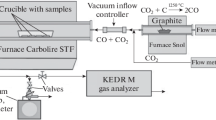Abstract
The mechanical properties of a tungsten-free cemented carbide subjected to thermal oxidation in air have been found to be fairly dependent on the isothermal holding time. The strength parameters of the material are affected by the oxidation of the materials and the higher Ni content in the metal-binder. That increase is due to the decomposition of the Ni3Mo intermetallic phase during heat treatment of the cemented carbide in air.
Similar content being viewed by others
References
É. F. Éikhmans, R. P. Asmolova, and N. I. Litvinyuk, “Cutting properties of tungsten-free hard alloys,” Tverd. Splavy, No. 22, 19–23 (1981).
A. Ya. Muzykant, and V. S. Samoilov, Cutting Tools with Plates of Tungsten-Free Hard Alloys [in Russian], NII Mashinostroeniya, Moscow (1984).
D. B. Gorodetskii, N. N. Sereda, and L. N. Beloborodov, “Finishing of carbon and corrosion-resistant steels with the tungsten-less hard alloy KTS-2M,” Tekhnolog. Sudostr., No. 7, 30 (1986).
G. T. Dzodziev, V. A. Shlyuko, K. K. Palekhov, and R. V. Kantor, “Oxidizability of materials based on TiC and Ti at elevated temperatures,” Poroshk. Metall., No. 4, 76–78 (1988).
V. A. Zhilyaev, “Structural-chemical studies of high-temperature oxidation of some transition metals of groups IV and V with carbon, nitrogen, and oxygen,” Author’s Abstract of Candidate’s Dissertation [in Russian], Sverdlovsk (1974).
R. F. Voitovich, Oxidation of Carbides and Nitrides [in Russian], Nauk. Dumka, Kiev (1981).
V. A. Zhilyaev, V. D. Lyudilov, and G. P. Shveikin, “Mechanism of phase transformations under oxidation of titanium carbide in air,” Izv. Akad. Nauk SSSR. Neorg. Mater.,10, No. 1, 47–51 (1974).
É. I. Golovko, V. B. Voitovich, N. N. Sereda, and L. N. Beloborodov, “Mechanism of oxidation of a titanium-nickel, molybdenum hard alloy,” Poroshk. Metall., No. 4, 89–94 (1990).
V. B. Voitovich, É. I. Golovko, L. N. Beloborodov, and N. N. Sereda, “Influence of prolonged heating on the distinctive features of oxidation of titanium carbide hard alloy,” Poroshk. Metall., No. 9, 41–46 (1990).
O. V. Bakun, L. N. Beloborodov, O. N. Grigor'ev, et al., “Influence of the medium on the temperature dependence of the strength of the alloy KTS,” Poroshk. Metall., No. 5, 80–83 (1992).
G. V. Samsonov (ed.), Handbook of the Physicochemical Properties of Oxides [in Russian], Metallurgiya, Moscow (1969), pp. 400–407.
M. S. Koval’chenko, N. N. Sereda, and V. T. Bondar’, “Salient features of hard alloys based on titanium carbide,” Poroshk. Metall., No. 11, 98–102 (1985).
F. A. Shunk, Constitution of Binary Alloys, 2nd. Supplement, McGraw, New York (1969).
P. Hull, P. Beardmore, and A. Valintine, “Crack propagation in single crystals of tungsten,” Philos. Mag.,12, No. 119, 1021–1029 (1965).
Additional information
Institute of Metal Physics, Ukrainian Academy of Sciences of Ukraine, Kiev. Translated from Poroshkovaya Metallurgiya, Nos. 11-12, pp. 71–75, November–December, 1997.
Rights and permissions
About this article
Cite this article
Drachinskii, A.S., Timofeeva, I.I., Rogozinskaya, A.A. et al. Variation of the phase composition and strength characteristics of a tungsten-free hard alloy in the early stage of oxidation. Powder Metall Met Ceram 36, 629–632 (1997). https://doi.org/10.1007/BF02676152
Received:
Issue Date:
DOI: https://doi.org/10.1007/BF02676152




